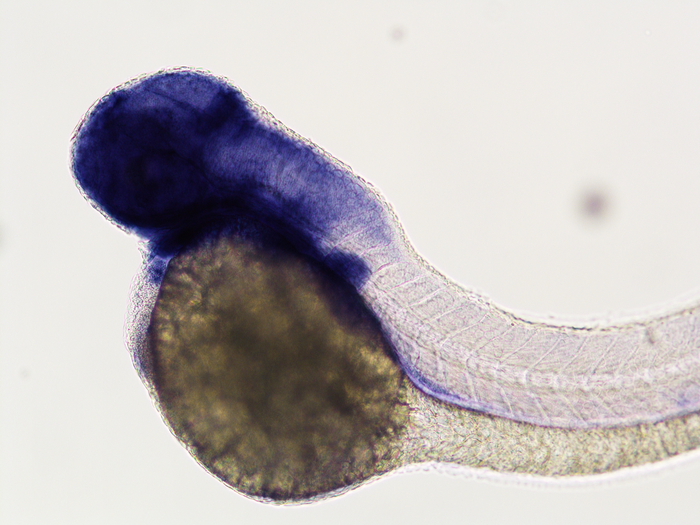An international study led by the medical Faculty of the University of Bonn has identified a gene that plays an important role in the development of the human embryo. If it is altered, malformations of various organ systems can result. The gene emerged very early in evolution. It also exists in zebrafish, for example, and performs a similar function there. The results have now been published in the Journal of Medical Genetics.

Credit: Photo: Dr. Kolvenbach & Dr. Dworschak / University of Bonn
An international study led by the medical Faculty of the University of Bonn has identified a gene that plays an important role in the development of the human embryo. If it is altered, malformations of various organ systems can result. The gene emerged very early in evolution. It also exists in zebrafish, for example, and performs a similar function there. The results have now been published in the Journal of Medical Genetics.
The researchers tracked down the gene when they studied two individuals with congenital malformations. “It was a man and his niece,” explains Dr. Gabriel Dworschak. “Both had malformed kidneys, urinary tract and esophagus, and the man also had a malformed right arm and heart.”
The physician at the University Children’s Hospital in Bonn conducts research on rare genetic diseases at the Institutes of Anatomy and Human Genetics. When the team looked at the genetic makeup of the family members, they came across an anomaly: A gene called SHROOM4 was altered in affected individuals compared to healthy individuals.
SHROOM4 was already familiar from another context: It was known to play a key role in brain function. Mutations can result in intellectual impairment, epileptic seizures and behavioral abnormalities. “Our findings indicated though, that it may play a broader role in embryonic organ development,” Dworschak explains.
The team from Bonn searched internationally for other cases in which abnormalities in the SHROOM4 gene had also been found – and succeeded: “Together with our cooperation partners, this led us to four more affected individuals from three families,” says Prof. Dr. Heiko Reutter, who has since moved from the University Hospital Bonn to the University of Erlangen-Nuremberg. “All of them had the SHROOM4 gene altered, but not always in the same way.”
Zebrafish also needs SHROOM4
However, this did not necessarily clarify whether SHROOM4 variants were actually responsible for the malformations. But there is an animal that has a very similar gene: the zebrafish. It serves as a model organism in many genetic studies today – and not only because it is easy to keep in a species-appropriate manner and to reproduce quickly: The skin of its larvae is almost transparent. This makes it easy to observe the animals’ embryonic development under the light microscope. “Here at the University Hospital, we have the advantage that the research group led by Prof. Dr. Benjamin Odermatt from the Institute of Neuroanatomy works a lot with zebrafish,” stresses Dr. Caroline Kolvenbach, who was also involved in the study of SHROOM4. “This expertise came in handy in our study.”
The researchers almost completely inactivated SHROOM4 in the larvae. The animals then showed malformations similar to those seen in the patients. If, on the other hand, larvae with SHROOM4 switched off were injected with the intact human genetic material, they developed almost normally. “This shows first that they absolutely need a functional SHROOM4 for healthy development; and second, that the human gene can still take over the function of the fish gene,” Dworschak emphasizes.
The team now wants to find out which part the gene plays in embryonic development. “We assume that it is needed for very basic processes in the cell,” says Dworschak. “It’s hard to explain otherwise why changes in the same gene cause such a variety of symptoms.”
Small piece in the mosaic of an extremely complex picture
How a mouse, a dog or a human being develops from a fertilized ovum is still not fully understood. This is because the ovum has the ability to form any type of tissue in the organism, whether it is bone, skin, muscle or the brain. Its daughter cells are genetically identical to it; so in principle they should be able to do the same. But at a very early stage, certain programs are activated in their cells that irrevocably determine their developmental fate.
This process must be coordinated down to the finest detail. Because only then it is ensured that the eyes form in the appropriate spot on the face, while other cells very close by differentiate into the nasal cartilage. Surprisingly, however, there is no conductor wielding the baton. It is as if a Lego spaceship were assembling itself – only infinitely more complicated. “Our study is a small piece of the mosaic to this picture, which is still largely incomplete,” Dworschak says.
Participating institutions and funding:
In addition to the University of Bonn and the University Hospital Bonn, the study involved Children’s Mercy Hospital (USA), the Medical University of Silesia (Poland), the University of Zielona Góra (Poland), the University of Southern Denmark (Denmark), the University of Cologne, the University of Heidelberg, the University of Erlangen-Nuremberg, Medeor Hospital Lodz (Poland), and Goethe University Frankfurt. The work was supported by the German Research Foundation (DFG), the BONFOR program of the University Hospital Bonn, the Else Kröner-Fresenius Foundation, the Luise and Horst Köhler Foundation, and the National Institutes of Health (USA).
Publication: Caroline M. Kolvenbach et al.: X-linked variations in SHROOM4 are implicated in congenital anomalies of the urinary tract, the anorectal, the cardiovascular, and the central nervous system; Journal of Medical Genetics; DOI: 10.1136/jmg-2022-108738
Contact:
Dr. Gabriel Dworschak
University Children’s Hospital in Bonn
Institutes of Anatomy and Human Genetics
Phone: +49 228 739033
E-mail: [email protected]
Journal
Journal of Medical Genetics
DOI
10.1136/jmg-2022-108738
Method of Research
Experimental study
Subject of Research
Animals
Article Title
X-linked variations in SHROOM4 are implicated in congenital anomalies of the urinary tract, the anorectal, the cardiovascular, and the central nervous system
Article Publication Date
15-Nov-2022




